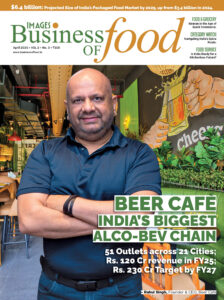The Indian restaurant industry is witnessing several evolving trends that include technology integration, sustainability practices, delivery and takeout services, health-conscious offerings, personalization, cloud kitchens, and social media influence.
The restaurant industry in India plays a pivotal role within the broader hospitality sector, dedicated to providing culinary services and creating inviting spaces for patrons to savor their meals. In India, this industry flourishes as a dynamic and lively domain, mirroring the nation’s rich tapestry of culinary traditions and epicurean wonders.
India offers an extensive spectrum of dining options, spanning from unassuming street food vendors to opulent fine dining establishments. The food service market in India is poised for significant growth, with an anticipated value of $79.65 billion by 2028, surging from $41.1 billion in 2022 at a notable CAGR of 11.19%.
The restaurant industry holds a pivotal position in molding the cultural landscape of India, as it caters to the diverse tastes and preferences of its vast population. More than just offering delicious cuisine, it serves as a platform for culinary exploration, joyous celebrations, and meaningful social interactions. Be it during festive festivities, special occasions, or even for a simple, satisfying meal, restaurants serve as a unifying force, nurturing a sense of community among people.
Historical Significance
The roots of the Indian restaurant industry delve deep into the annals of the nation’s history. Its origins can be traced back to a time when India served as a bustling crossroads of culture and commerce, welcoming travelers, traders, and pilgrims from diverse regions, each carrying their own culinary traditions and influences. These interactions and cultural exchanges laid the foundation for the birth of “dhabas,” unpretentious roadside eateries that served as essential refuges, providing sustenance and comfort to weary wayfarers.
Over time, these humble establishments underwent a remarkable metamorphosis, evolving into specialized restaurants that take immense pride in showcasing and celebrating the rich tapestry of India’s regional cuisines. These specialty restaurants stand as paragons of culinary excellence, offering a rich array of flavors, spices, and culinary techniques
From the succulent kebabs of Lucknow to the aromatic curries of Kerala, the Indian restaurant industry has thrived as a living testament to the nation’s culinary legacy, serving as a gateway for both locals and visitors to savor the authentic and diverse flavors of India
Culinary Diversity
The Indian restaurant industry stands as a veritable treasure trove of culinary diversity, offering a breathtaking array of fl avors and cuisines. One of its most striking features is the rich tapestry of regional culinary traditions that grace its menus. Each state in India takes pride in showcasing its unique gastronomic heritage, defined by a distinctive fusion of spices, cooking methods, and flavors.
From the sumptuously creamy curries of Punjab to the piquant and zesty delicacies of Andhra Pradesh, and the fragrant, multilayered biryanis of Hyderabad, every region boasts its own signature dishes, which have seamlessly found their way onto restaurant menus across the nation. The popularity of Indian cuisine has elevated India to a prominent tourist destination, drawing millions of visitors annually who yearn to relish the country’s distinctive culinary offerings.
Furthermore, Indian restaurants have proliferated in cities worldwide, enabling people to savor the delights of Indian cuisine without venturing far from home.
Beyond its appeal to tourists, Indian cuisine plays a substantial role in bolstering the Indian economy. The food service sector is a major source of employment in India, yielding billions of dollars in revenue each year. Additionally, Indian cuisine has emerged as a significant export, promoting Indian culture and tourism on the global stage. The Indian restaurant industry continues to flourish, captivating diners with its diverse culinary tapestry and standing as a cultural envoy for India’s multifaceted culinary heritage.
Evolving Trends
The restaurant industry is constantly evolving, driven by changing consumer preferences, technological advancements, and societal shifts. Some of the prominent trends shaping the restaurant industry include:
- Technology Integration
Restaurants are increasingly adopting technology to enhance the customer experience. This includes online ordering systems, mobile apps for reservations and payments, self-service kiosks, and digital menu boards. Technology also plays a significant role in streamlining operations, such as inventory management and kitchen automation.
2. Sustainable Practices
There is a growing focus on sustainability and eco-consciousness in the restaurant industry. Consumers are increasingly seeking establishments that have implemented environmentally friendly practices, including the use of locally sourced ingredients, reducing food waste, implementing composting and recycling programs, and offering plant-based or sustainable protein options.
3. Delivery and Takeout
The rise of third-party delivery platforms and the convenience-driven culture has led to an increased emphasis on delivery and takeout services. Many restaurants are partnering with delivery services or developing their own delivery networks, like Swiggy and Zomato, to meet customer demand for off-premise dining options.
4. Health-conscious Offerings
As consumers become more health-conscious, there is a greater demand for healthier menu options. Restaurants are responding by offering plant-based and vegetarian dishes, catering to specific dietary needs (gluten-free, keto, etc.), and providing nutritional information on their menus.
5. Personalization and Customization
Customers increasingly seek personalized dining. Restaurants are leveraging technology to offer customizable menu items, allowing customers to tailor their meals according to their preferences. This includes build-your-own dish or meal options, dietary substitutions, and interactive menus.
6. Cloud Kitchen and Ghost Kitchens
The emergence of virtual restaurants and ghost kitchens is revolutionizing the restaurant industry. Cloud kitchens operate solely through online platforms, focusing on delivery and takeout, while ghost kitchens are facilities designed specifically for delivery-only operations, often hosting multiple restaurant concepts under one roof.
7. Social Media Influence
Social media platforms have become powerful restaurant marketing tools. The industry is leveraging platforms like Instagram and TikTok to showcase visually appealing dishes, engage with customers, and build brand awareness. Influencer marketing and user-generated content also play a significant role in driving restaurant visibility and attracting new customers.
These evolving trends reflect the changing landscape of the restaurant industry as businesses adapt to meet consumer expectations, embrace technology, and prioritize sustainability and customization. Staying abreast of these trends is crucial for restaurants to remain competitive and relevant in the ever-evolving market.




